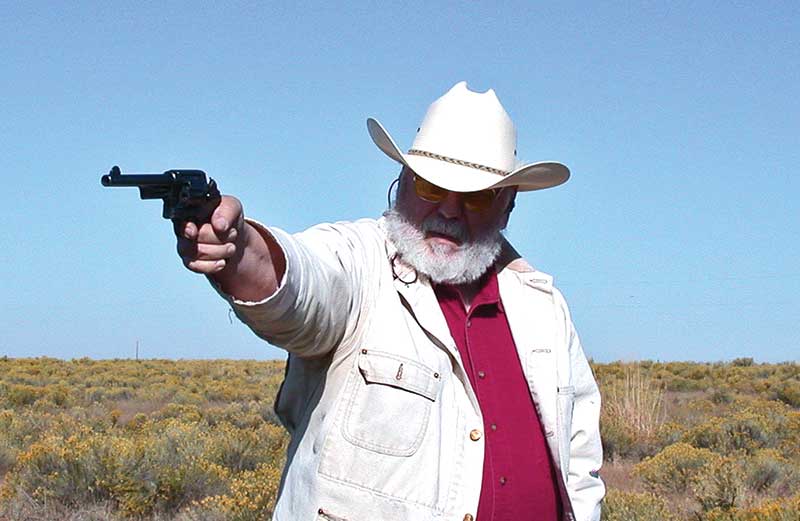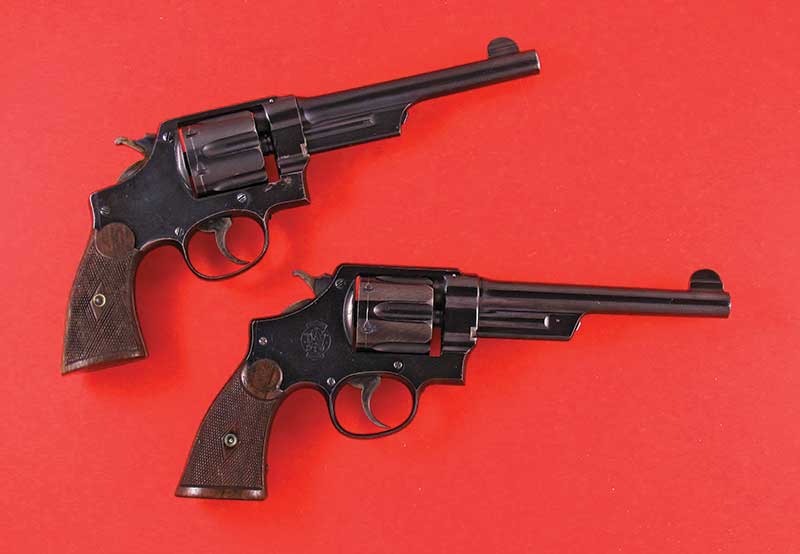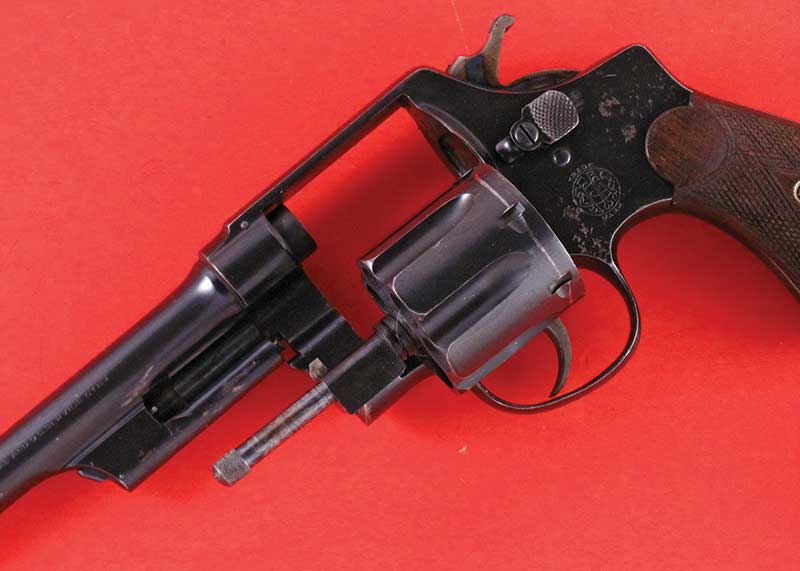For more than 100 years Colt and Smith & Wesson competed with each other to see who could come up with the most modern model first. Of course, Colt had started in 1836 with the first truly workable revolver, the percussion Paterson. In 1857, S&W introduced the Model 1, a 7-shot, tip-up .22 which was the first successful cartridge-firing revolver.
Then 1869 saw the first big-bore centerfire sixgun with the S&W .44 American and then Colt countered in 1873 with the first solid frame—the .45 Single Action Army. While Colt was on a roll they went double action with the 1877 Lightning followed by the 1878 Double Action. S&W came-right back in 1881 with the double action version of their single-action New Model 3.
Before the close of the 19th century both companies were ready to look to the future and Colt introduced the Army, Navy and New Service Models, all double actions with swing-out cylinders. By 1899 S&W had the .38 revolver which would become known as the Military & Police. All of these double actions locked only at the rear of the cylinder, however S&W soon added a second lock under the barrel in front of the ejector rod. At this point only Colt had a big-bore double action revolver with a swing-out cylinder. That was about to change.
The Triple Lock
In late 1907, S&W brought out their first big-bore modern double action with the New Century. The competition was the Colt New Service which only locked at the rear of the cylinder and had an exposed ejector rod. The New Century was the first of what would become the N-Frames and was chambered in a somewhat modernized version of the excellent .44 Russian cartridge. It was lengthened slightly, about 2/10″ to become the .44 Special, however the ballistics stayed basically the same. S&W countered the single lock/exposed ejector rod of the Colt by not only using a lock at the end of the ejector rod but also completely enclosing said rod. However S&W engineers did not stop there.
The New Century, also known as the .44 Hand Ejector First Model, would soon be known to all those who really appreciated it as the Triple Lock. Not only was this new sixgun chambered in a new cartridge using an enlarged Military & Police frame, improved with the use of the shroud to enclose the ejector rod which protected the rod, and also improved the looks of the S&W revolver. And S&W did not stop there, either.
The Triple Lock got its name because of a third lock brilliantly machined in the front of the frame at the yoke and barrel junction to solidly lock the cylinder in place. Even to this day many sixgun lovers will tell you the S&W Triple Lock is the finest revolver ever produced. Alas, it didn’t last very long. By 1915 the third lock as well as the enclosed ejector rod were gone. Why did S&W drop the .44 Special Triple Lock? Could it have been too expensive to produce? It can’t be for that reason as the Second Model of 1915 only sold for $2 less; for a measly $2 what may have been the finest sixgun ever produced disappeared.
Actually the blame probably rests upon the British. They were at war in Europe and ordered 5,000 Triple Locks chambered in .455 for use in the trench warfare of the time. The precise fitting of that extra third locking feature as well as the enclosed ejector rod was an object of concern when matched up with the muddy trenches. If either the lock or ejector rod housing became caked with mud the revolver would be out of commission until thoroughly cleaned. Removing both features resulted in what they thought was a firearm better suited to the conditions.
Was the third lock even necessary? In their book S&W 1857-1945, authors Robert Neal and Roy Jinks say, “Most authorities believe that the third lock provided on this model was put there by S&W more as an example of the ultimate in precision machine work than as a necessary item for extra strength. Even with S&W’s normal two locks they provided twice the locking strength of any Colt Hand Ejector arm then produced, along with the extra accuracy of the forward lock in keeping the cylinder in line with the barrel.” Why was the third lock there? Because it could be.
The Triple Lock was very popular with peace officers especially those in the Southwest and along our southern border. The pre-WWII S&Ws are usually referred to as having long actions, which were particularly good for shooting double-action style. As new peace officers came along a demand arose for a return to the Triple Lock or at least an enclosed ejector rod housing. S&W did not feel the demand warranted such a return until Wolf & Klar of Fort Worth, Texas, placed an order for 3,500 .44 Specials in 1926. The shrouded ejector rod was back but the Triple Lock was never to be seen again, or at least I thought so. The Triple Lock did come back but not through S&W.
In the August 1979 issue of the American Riflemen there is a picture of what was then a new Triple Lock. Built with a 4″ barrel with a ventilated rib and smooth Roper-style grips, this Triple Lock was produced by Rossi and chambered in .44 Magnum. No one seems to know whatever happened to it; however, there may have been two of them made.
Spanish Connection
For all these years as far as I knew there were no other Triple Locks ever produced. Then I got a phone call from my good friend J.D. Jones telling me he had found a Modelo Silo Nuevo, a Spanish copy of the Triple Lock or, if you please, a Candida Triple. J.D. was going to buy it himself but figured I would appreciate it much more since I am so enamored and captivated by the .44 Special. He gave me the name of the Ohio gunshop which I immediately called and for $300 plus shipping I had a Spanish Triple Lock. Where in the world did it come from?
The answer comes from the late Dan Shideler. We all know, if we’ve been around handguns very long, that Spain had been copying both S&W and Colt revolvers since the frontier days. This particular revolver came from Trocaola, Aranzabal y Cia (or TAC) of Eibar, Spain. This company began in 1905 and by the time of the Spanish Civil War in 1936 was out of business. Unlike many other Spanish revolvers there is no way these could be classified as junk and in fact Great Britain not only purchased .455 Triple Locks from S&W for use in WWI they also bought Webley copies from TAC.
The original S&W Triple Lock was never adopted as US military issue, however the Spanish version is officially known as the Modelo Militar. The Spanish considered revolvers with adjustable sights as target guns while fixed-sighted versions were considered military-style revolvers. TAC was obviously proud of their “Candado Triple” as they made no attempt to pass it off as a S&W. Many of those other S&W-style revolvers had such a misleading mark on the barrel as “For the SMITH & WESSON cartridge.” Many years ago, I answered an ad in the local paper and went to look at a pair of “Smith & Wessons” for sale. When I told the seller they were not S&Ws but actually Spanish copies, she became very indignant and practically threw me out of the house. However, the following week they were advertised in the paper once again for a lot less money.
My new Triple Lock seems to be very well-made, looks exactly like a 6-1/2″ fixed-sight S&W Triple Lock and is finished in bright blue with excellent checkered walnut stocks. Case colors on hammer and trigger are both still quite brilliant. The only down side is the fact the chamber mouths are well over size at .437″. The only loads I had made up for test-firing with bullets even close were .432″; next spring I will try some larger bullets and hope I can do better than the 2″ groups I am now getting.
While there is no attempt to pass this off as a genuine S&W it is somewhat humorous to read what it says on the barrel. On the left side we find: “FOR 44 SPECIAL AND U.S. SERVICE CTG” (I don’t know of any US service cartridge which will fit in a .44 Special). Then on the top we find: “BEST AMERICAN CARTRIDGES ARE THOSE THAT FIT BEST THE TAC REVOLVER.” At least they’re not warning labels! At my age discovering something new is pretty rare. This Candado Triple from Spain is worth much more than the price of admission to me. Thanks J.D.


